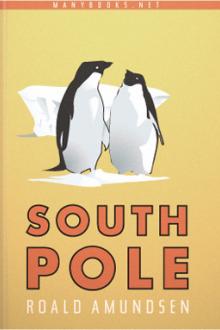The North Pole by Robert E. Peary (room on the broom read aloud .TXT) 📕

- Author: Robert E. Peary
- Performer: -
Book online «The North Pole by Robert E. Peary (room on the broom read aloud .TXT) 📕». Author Robert E. Peary
KUDLAH, ALIAS "MISFORTUNE," WITH PUPPIES
My own observations of this interesting people have taught me to repose no confidence whatever in the tales of barbaric craft and cruelty which I have heard of them. On the contrary, taking into consideration their uncivilized state, they must be ranked as a humane people. Moreover, they have always been quick to grasp the purposes that I have had in view and to bend their energies toward achieving the ends for which my expeditions have been striving.
Their humanity, as has been indicated, takes a form that would delight a socialist. They are generous and hospitable in a crude way, almost without exception. As a general rule, good and bad fortune are shared. The tribe shares in the proceeds of good luck on the part of the hunters and, as their existence depends on hunting, this accounts in large measure for the preservation of the tribe.
CHAPTER VII ODD CUSTOMS OF AN ODD PEOPLEHard as is the life of the Eskimo, his end is usually as rigorous. All his life he is engaged in constant warfare with the inhospitable elements of his country, and Death, when it arrives, usually comes in some violent form. Old age has few terrors for the Eskimo, for he seldom lives to reach it. He dies, as a rule, in harness, drowned by the capsizing of his skin canoe, caught by the overturning of an iceberg, or crushed by a snow-slide or a rock-slide. It is seldom that an Eskimo lives to be more than sixty years of age.
Strictly speaking, the Eskimos have no religion, in the sense in which we use the word. But they believe in the survival of the person after death, and they believe in spirits—especially evil spirits. It may be that their lack of any idea of a beneficent God, and their intense consciousness of evil influences, result from the terrible hardships of their lives. Having no special blessings for which to be grateful to a kind Creator, they have not evolved a conception of Him, while the constantly recurring menaces of the dark, the bitter cold, the savage wind and gnawing hunger, have led them to people the air with invisible enemies. The beneficent spirits are those of their ancestors (another Oriental touch), while they have a whole legion of malevolent spirits, led by Tornarsuk, the great devil himself.
They are constantly trying to propitiate Tornarsuk by incantations; and when they kill game, an offering is made to him. The devil is supposed to have a keen appreciation of these tidbits. On leaving a snow igloo the Eskimos are careful to kick the front out of it, that the evil spirits may not find shelter there, and when they throw away a worn-out garment it is never left intact, but is torn in such a way that the devil may not use it to warm himself. A comfortable devil is presumably more dangerous than a shivering one. Any sudden and unexplained barking or howling among the dogs indicates the invisible presence of Tornarsuk, and the men will run out and crack their whips or fire their rifles to scare away the invader. When, on board the Roosevelt in winter quarters, I was suddenly aroused from sleep by the crack of rifles, I did not think there was a mutiny aboard—only that Tornarsuk had ridden by upon the wind.
When the ice presses hard against the ship, an Eskimo will call on his dead father to push it away; when the wind blows with special violence, ancestors are again appealed to. Passing along a cliff, on a sledge journey, a man will sometimes stop and listen and then say: "Did you hear what the devil said just then?" I have asked the Eskimo to repeat to me the words of Tornarsuk, up there on the cliff, and I would not dream of laughing at my faithful friends at such a time; the messages of Tornarsuk I receive with a respectful gravity.
There are no chiefs among these people, no men in authority; but there are medicine men who have some influence. The angakok is generally not loved—he knows too many unpleasant things that are going to happen, so he says. The business of the angakok is mainly singing incantations and going into trances, for he has no medicines. If a person is sick, he may prescribe abstinence from certain foods for a certain number of moons; for instance, the patient must not eat seal meat, or deer meat, but only the flesh of the walrus. Monotonous incantations take the place of the white man's drugs. The performance of a self-confident angakok is quite impressive—if one has not witnessed it too many times before. The chanting, or howling, is accompanied by contortions of the body and by sounds from a rude tambourine, made from the throat membrane of a walrus stretched on a bow of ivory or bone. The tapping of the rim with another piece of ivory or bone marks the time. This is the Eskimo's only attempt at music. Some women are supposed to possess the power of the angakok—a combination of the gifts of the fortune teller, the mental healer, and the psalmodist, one might say.
Once, years ago, my little brown people got tired of an angakok, one Kyoahpahdo, who had predicted too many deaths; and they lured him out on a hunting expedition from which he never returned. But these executions for the peace of the community are rare.
Their burial customs are rather interesting. When an Eskimo dies, there is no delay about removing the body. Just as soon as possible it is wrapped, fully clothed, in the skins which formed the bed, and some extra garments are added to insure the comfort of the spirit. Then a strong line is tied round the body, and it is removed, always head first, from the tent or igloo, and dragged head first over the snow or ground to the nearest place where there are enough loose stones to cover it. The Eskimos do not like to touch a dead body, and it is therefore dragged as a sledge would be. Arrived at the place selected for the grave, they cover the corpse with loose stones, to protect it from the dogs, foxes, and ravens, and the burial is complete.
According to Eskimo ideas, the after-world is a distinctly material place. If the deceased is a hunter, his sledge and kayak, with his weapons and implements, are placed close by, and his favorite dogs, harnessed and attached to the sledge, are strangled so that they may accompany him on his journey into the unseen. If the deceased is a woman, her lamp and the little wooden frame on which she has dried the family boots and mittens are placed beside the grave. A little blubber is placed there, too, and a few matches, if they are available, so that the woman may light the lamp and do some cooking in transit; a cup or bowl is also provided, in which she may melt snow for water. Her needle, thimble, and other sewing things are placed with her in the grave.
In former years, if the woman had a small baby in the hood it was strangled to keep her company; but I have, of course, discouraged this practice, and during the last two expeditions I have not heard of any strangled babies. Among the members of my own party I have simply forbidden the practice, and have promised the relatives sufficient condensed milk and other foods to keep the infant alive. If they have reverted to the old custom during my absence, they have not mentioned the fact to me, knowing of my disapproval.
If a death occurs in a tent, the poles are removed, and the tent is left on the ground to rot or blow away. It is never used again. If the death occurs in an igloo, the structure is vacated and not used again for a long time. The relatives of the dead observe certain formalities in regard to food and clothing, and the name of the lost one is never mentioned. If any other members of the tribe have the same name, they must take another until an infant is born to which the proscribed name can be given. This appears to remove the ban.
Eskimos are children in their grief, as in their pleasure; they weep for a dead friend a few days, then they forget. Even a mother who has been inconsolable at the death of her baby soon laughs again and thinks of other things.
In a country where the stars are visible for so many weeks at a time it is not strange perhaps that they receive much attention from the natives. The Eskimos are, within barbaric limits, astronomers. The principal constellations visible in northern latitudes are well known to them and they have given them their own names and descriptions. In the Great Dipper they see a herd of celestial reindeer. The Pleiades are to the Eskimos a team of dogs pursuing a solitary polar bear. Gemini they describe as two stones in the entrance of an igloo. The moon and the sun represent to the Eskimo, as to some of our North American Indian tribes, a fleeing maiden and her pursuing admirer.
Time is, of course, of small value to the Eskimo, so far as he is himself personally concerned, yet after the Eskimo has been trained to the ways of the white man he seems to absorb an excellent notion of the value of punctuality and will carry out orders with a surprising degree of promptness and despatch.
The strength and capacity for enduring hardships exhibited by this people is extraordinary and is not, I believe, exceeded by that shown by any other aboriginal race now in existence. It is true that the average size of the Eskimo is, judged by our own standards, small; but I could give the names of several of them who stand five feet ten inches and weigh 185 pounds. The popular idea that they are clumsily fashioned is not correct. That notion is merely another case of judging a man by the clothes he wears, and an Eskimo's garments are not precisely what we should call of fashionable cut.
To my mind, the skin canoe of these Northern aborigines is, with its hunting implements, one of the most complete and ingenious manifestations of intelligence to be found in any aboriginal tribe. Over a light framework, an almost infinite number of small pieces of wood deftly lashed together with sealskin thongs, is stretched the tanned skin of seals, the seams being neatly sewed by the women, and then rendered water-tight by an application of seal oil and soot from the native lamps. The result is a craft of great buoyancy, some grace, and especial fitness and effectiveness for the purposes for which it is intended, that is, to enable the hunter to creep softly and noiselessly upon seal, walrus, or white whale. This





Comments (0)